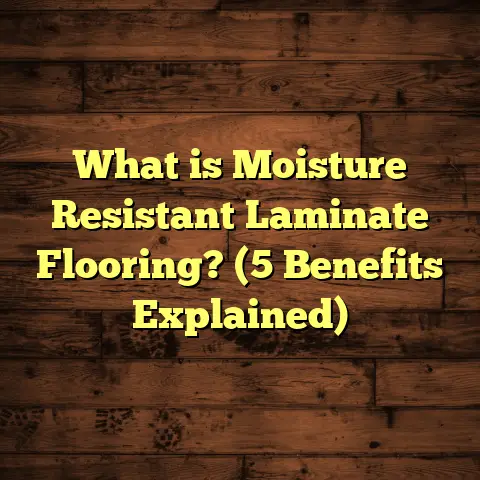What is Hardwood Strip Flooring? (5 Benefits & Installation Tips)
Children spend so much time on the floor—crawling, playing, and sometimes even eating snacks right where they sit. As a parent or caregiver, choosing the right flooring feels like a big deal because you want a surface that’s safe, durable, and looks beautiful. I’ve been in the flooring business for years, and hardwood strip flooring has been one of my favorite options to recommend for family homes. It’s classic, strong, and has some cool benefits you might not expect.
What is Hardwood Strip Flooring?
Hardwood strip flooring is a type of solid wood flooring made up of narrow strips of hardwood that are usually between 1¾ inches to 2¼ inches wide. These strips come from solid pieces of hardwood lumber and are laid side by side to create a continuous, natural wood surface. The strips are typically longer than they are wide, often around 18 inches to 84 inches in length, allowing for a seamless appearance when installed.
One of the key things that makes hardwood strip flooring unique is its size and installation style. The narrow strips make it easier to handle and install compared to wider planks that are more susceptible to warping and gaps. Because each strip is solid wood, you can sand and refinish the floor multiple times over its lifespan, which means your floor can stay looking fresh for decades.
When I first started working with hardwood floors, I noticed how different species of wood—oak, maple, cherry, hickory, and walnut—each brought their own character to the room. Whether you prefer the classic light tones of white oak or the rich reddish hues of cherrywood, hardwood strip flooring offers many options to fit your style.
The manufacturing process usually involves carefully milling the wood into uniform strips with tongue-and-groove edges. This design allows the strips to lock tightly together during installation, minimizing gaps and movement.
Historical Context
Hardwood strip flooring dates back over a century and was commonly used in early 20th-century homes throughout North America and Europe. Its popularity grew because of its durability and relatively easy installation compared to wide plank flooring available at the time. Many historic homes still feature original hardwood strip floors that have lasted over 100 years with proper care.
In recent years, hardwood strip floors have made a comeback as people look for authentic natural materials over synthetic flooring options. The timeless appeal and long-term value make this style a favorite among homeowners and designers alike.
5 Benefits of Hardwood Strip Flooring
1. Durability That Stands Up To Kids’ Play
Kids can be tough on floors – spills, dropped toys, and constant running around. Hardwood strip flooring takes this challenge head-on. Because it’s made from solid wood, it can handle heavy foot traffic without showing wear quickly.
When I installed hardwood strips in a home with three kids under 10, the parents were worried about scratches and dents. Two years later, despite daily play sessions and occasional spills, the floor showed minimal damage. After a quick sanding and re-coating, the floor looked almost new again.
Data point: According to the National Wood Flooring Association (NWFA), solid hardwood floors can last over 100 years with proper care and refinishing every 7-10 years.
Hardwood’s hardness varies by species. For instance:
- Oak: 1,290 on Janka hardness scale (popular for its balance of hardness and grain)
- Maple: 1,450 (harder than oak and resists dents better)
- Cherry: 995 (softer but ages beautifully with color change)
- Hickory: 1,820 (one of the hardest woods available)
Choosing the right species based on your household’s activity level can make a big difference.
2. Easy to Maintain and Repair
One big worry for parents is how to clean up after kids easily. Hardwood strip flooring is surprisingly low-maintenance. Regular sweeping or vacuuming removes dust and dirt that can scratch the surface.
A damp mop with a cleaner specifically designed for wood floors keeps the surface clean without damaging the finish.
Unlike carpet that traps allergens and stains harder to remove, hardwood surfaces are easier to clean thoroughly—great for kids with allergies or asthma.
If your child accidentally dents or scratches the surface? You can sand just the damaged strip and refinish it instead of replacing the entire floor. This localized repair saves time and money compared to other floorings like laminate or vinyl.
3. Natural Warmth and Comfort
Hardwood floors don’t just look good—they feel good too. The natural wood surface provides a warmer feel underfoot compared to tile or stone floors, which can be cold for little ones playing on the ground.
I recall visiting a friend whose kids loved sitting on their hardwood strip floor during storytime because it wasn’t chilly or hard like tile.
Adding area rugs in play zones further enhances comfort while protecting the floor in high-traffic spots.
4. Versatility in Design
One thing I love about hardwood strip flooring is how versatile it is in design. Because the strips are narrow, you have more flexibility in patterns like straight lay (classic parallel rows), herringbone (zigzag pattern), or basketweave.
Different wood species offer a range of colors—from light blond maple to deep reddish cherry—letting you tailor the look to your home’s style.
Finishes also add versatility: from matte natural looks to glossy polyurethane coatings or hand-scraped textures for rustic charm.
5. Increases Home Value
Homeowners often ask me if investing in hardwood strip flooring is worth it financially. The answer is a clear yes. Hardwood floors remain one of the top features buyers look for when purchasing a home.
According to real estate data:
- Homes with hardwood floors sell faster.
- Hardwood can boost home resale value by up to 2% compared to homes without it (National Association of Realtors).
- Hardwood floors have a universal appeal across different buyer demographics.
This means your investment today could pay off when you decide to sell or refinance your home later.
Installation Tips for Hardwood Strip Flooring
Installing hardwood strip flooring isn’t overly complicated but does require some care to get it right. Here’s what I’ve learned from years of hands-on work:
Prepare Your Subfloor Thoroughly
Before laying any wood strips, make sure your subfloor is clean, dry, and level. Uneven surfaces can cause squeaks or gaps later on. For wooden subfloors, I recommend using an underlayment that reduces noise and adds moisture protection.
For concrete subfloors (common in basements), a vapor barrier is critical to prevent moisture seeping up and damaging your wood strips.
Acclimate Your Wood Strips
Wood expands and contracts based on humidity levels. To avoid surprises after installation, leave your hardwood strips in the room where they’ll be installed for at least 3-5 days before starting work. This allows them to adjust naturally to temperature and moisture conditions.
I’ve seen cases where skipping this step caused boards to buckle or gaps to appear after installation due to wood swelling or shrinking.
Use Proper Tools and Adhesives
Nail-down installation is common on wooden subfloors using specific flooring nails or staples driven at an angle through the tongue edge of each strip.
For concrete subfloors or radiant heating systems, glue-down methods with high-quality adhesives work best to secure the strips firmly.
In my experience, using pneumatic nailers speeds up installation significantly while reducing mistakes compared to manual nailing.
Leave Expansion Gaps
Wood needs room to expand with changes in humidity. Leave about a ½ inch gap around the edges of the room near walls or fixed objects like cabinets. These gaps allow natural expansion without causing buckling or warping.
After installation, cover these gaps with baseboards or quarter-round molding for a clean finish that hides expansion space while keeping flexibility.
Sanding and Finishing
Once all strips are down, sanding smooths out unevenness between boards and removes any minor surface defects from installation.
Then apply your finish—whether oil-based polyurethane (durable but longer drying time) or water-based finishes (eco-friendly with quick drying). Some homeowners prefer penetrating oils for a natural look but they require more upkeep over time.
I always recommend two or three coats of finish applied evenly for maximum protection against wear and moisture.
Personal Story: A Family Flooring Project
A couple years ago, I helped a family choose flooring for their new home focused on safety and longevity for their two young kids. They were torn between carpet and hardwood strip flooring.
We talked about how kids’ spills and messes could ruin carpet quickly but wouldn’t harm properly finished wood floors as much. They also loved that hardwood could be refinished rather than replaced after years of use.
After installation, the family told me their kids loved playing on the warm wood surface. The parents felt confident it was an investment that would last through thick and thin.
That project remains one of my favorites because it combined practicality with family-friendly comfort—exactly what many parents want in their homes.
Caring for Your Hardwood Strip Floors: Tips That Work
Maintenance isn’t just about cleaning; it’s also about protecting your investment so your floors maintain their beauty through years of kids’ playtime chaos.
Daily Cleaning Routine
Sweep or vacuum regularly using a soft brush attachment to avoid scratching the finish. Dirt and grit act like sandpaper underfoot when dragged around by shoes or pets.
Avoid wet mopping frequently as excess water can seep into seams causing swelling or warping. Instead, use a damp mop with a recommended wood floor cleaner when deeper cleaning is needed.
Protect High-Traffic Areas
Place rugs or mats at entrances to trap dirt before it reaches your wood floor inside. Using felt pads under furniture legs prevents scratches when moving heavy pieces during cleaning or rearranging rooms.
Handling Spills Quickly
Kids spill juice? No worries if you wipe spills immediately with a dry cloth—you prevent liquids from soaking into wood or finish layers which causes stains or damage.
Refinishing When Needed
Over time, your floor may develop surface scratches or dullness due to foot traffic—especially near play areas or hallways.
Refinishing involves sanding down the top layer then applying fresh finish coats restoring shine and durability without replacing boards.
Depending on wear levels:
- Light sanding + recoating every 7-10 years
- Full sanding + refinishing every 15-20 years
This cycle keeps floors looking great as your family grows up without huge costs associated with replacement.
Common Questions About Hardwood Strip Flooring
Can Hardwood Strip Flooring Handle Pets?
Absolutely! Hardwood is pet-friendly if maintained well. Dogs’ nails can scratch softer woods but regular trimming plus finishes designed for scratch resistance reduce visible damage significantly.
Species like hickory or maple are excellent choices for pet owners due to their hardness ratings.
Is Hardwood Strip Flooring Good for Basement Installations?
Typically no unless you have proper moisture control measures like vapor barriers and dehumidifiers since solid wood reacts poorly to damp environments causing warping over time.
Engineered hardwood might be better suited for basements due to its layered construction resisting moisture better.
How Does Humidity Affect Hardwood Strip Floors?
Wood naturally absorbs moisture from humid air causing expansion; dry conditions cause contraction. This movement is why expansion gaps are critical during installation plus maintaining indoor humidity between 30%-50% helps minimize issues year-round.
A humidifier during dry winters and dehumidifier during humid summers helps keep floors stable.
Case Study: Hardwood Strip Flooring in a Montessori School Playroom
I worked with a Montessori school renovating their children’s playroom flooring recently. The school wanted natural materials safe for kids while handling heavy daily use from active children ages 2-6 years old.
We chose white oak hardwood strip flooring finished with an eco-friendly matte polyurethane coating that provides excellent durability while reducing glare under bright classroom lights.
The results?
- Teachers reported fewer injuries from falls due to smooth yet slightly textured surface.
- Children enjoyed sitting comfortably on warm wood during group activities.
- Maintenance staff found cleaning easier compared to previous carpeted floor.
- The school administration appreciated long-term investment savings due to refinishable nature vs replacing worn carpet every few years.
This project highlights how hardwood strip flooring fits well in child-centric spaces beyond homes too!
Comparing Hardwood Strip Flooring With Similar Options
How does hardwood strip flooring stack up against other popular choices? Here’s a detailed comparison table including pros and cons:
| Flooring Type | Durability | Maintenance | Cost (per sq ft) | Appearance | Lifespan | Child-Friendly Features |
|---|---|---|---|---|---|---|
| Hardwood Strip | High | Moderate | $6 – $12 | Natural wood grain; timeless | 50+ years | Warm surface; easy spot cleaning |
| Engineered Hardwood | Moderate to High | Moderate | $4 – $10 | Wood veneer; variety of styles | 20-30 years | More moisture resistant; less sanding |
| Laminate | Moderate | Low | $1 – $5 | Wood-like appearance | 10-20 years | Scratch resistant but no refinishing |
| Vinyl Plank | Moderate | Low | $2 – $7 | Variety of textures/colors | 10-20 years | Waterproof; comfortable but synthetic |
| Carpet | Low | High (stains) | $2 – $7 | Soft texture; many colors | 5-10 years | Soft but traps allergens & dirt |
Why Choose Hardwood Strip Over Engineered Hardwood?
Engineered hardwood consists of a thin veneer of real wood over plywood layers which gives better moisture resistance but limits sanding/refinishing options — usually only once or twice in lifetime.
Hardwood strip allows multiple sandings making it ideal if you want longevity beyond two decades without replacement worries.
Laminate & Vinyl: Budget Alternatives But With Trade-Offs
Laminate mimics wood appearance but wears down quicker under heavy use especially from sharp objects kids drag across floors. Vinyl offers waterproof benefits but doesn’t provide the same warmth or authenticity that real wood brings into a home environment with children crawling around barefoot often.
If you’re thinking about upgrading your floors with something lasting and child-friendly, hardwood strip flooring deserves serious consideration—it’s been tried and tested in many homes I’ve worked in offering both charm and toughness that grows with your family.
Would you like tips on choosing the right wood species? Or advice on finishes suitable for households with children? Just ask!





